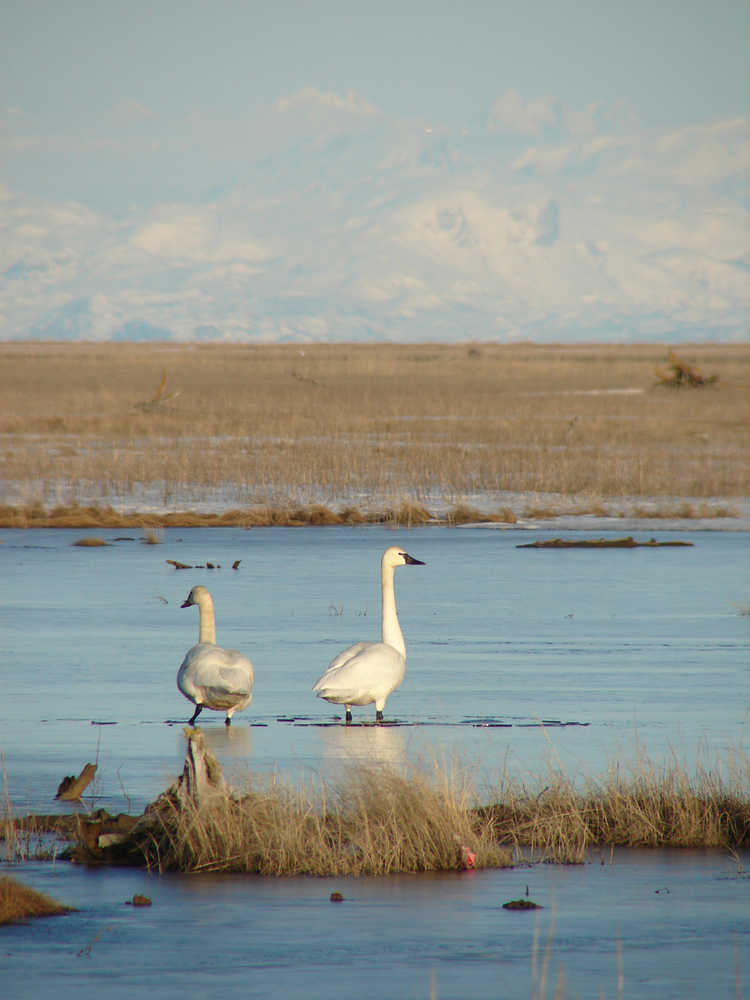As we say goodbye to our meager snow accumulation and brace ourselves for another warm week this winter, I can’t help but think about what these changing winter weather patterns are doing to bird distributions. As most birders will tell you, there is a unique and excited feeling we get when we see new bird species in our area. We are always searching for the rarities while enjoying the more common species.
The annual Christmas Bird Count was held recently in the Kenai-Soldotna area. One of the highlights is always the potluck at the end of the day when birders share stories of adventures and missed steps while pursuing secretive (but cool) little brown birds through rose thickets. The weather was perfect, the company was terrific, but this year’s highlights were mostly rooted in observed changes in bird distributions which probably doesn’t elicit that special feeling one gets from finding new birds.
Undoubtedly, the oddest sighting was of four Common Murres on the Kenai River near Swiftwater Park. It is not the first time that murres have appeared during the count but, on previous occasions when individuals were sighted, they were always in more appropriate places like the mouths of the Kenai or Kasilof Rivers. This year, murres are showing up all over South-central Alaska in bizarre places. Unfortunately, it appears these birds are related to a massive die-off that has been occurring from Northern California to the Bering Sea.
Die-offs are not unusual in seabird populations periodically, but the scale and magnitude of this one is unprecedented. All indications point to the persistence of warmer than normal ocean temperatures as the root cause for this massive starvation event. The “Pacific Blob” is a well-documented pocket of warm water (2 degrees warmer than normal) that has been hovering in the Pacific since 2014 and slowly moving closer to the U.S. and Canada.
While two degrees may not seem like much, it changes the diversity of zooplankton from the cold-loving crunchy forms like krill and shrimp to warm-loving more gelatinous species (squishies) that are lower in fat content and nutritional quality. Zooplankton is the food for prey fish and juvenile salmon. These small fish are in-turn eaten by millions of seabirds — even temporary changes in these cycles can result in mass starvation events like the one affecting seabirds currently.
In addition to sighting Common Murres in an odd location, record numbers of European Starlings and Rock Pigeons were also tallied in the Kenai area. These two species are very adept at subsisting around human inhabitants, so it is not a surprise that their numbers will continue to increase as the human population and footprint grow.
On a brighter note, huge numbers of Rock Sandpipers have returned to feed at the mouth of the Kasilof River. At one point several years ago there were as many as 10,000 Rock Sandpipers feeding primarily on pea-sized Baltic Macoma clams. In recent winters, the numbers observed here were only in the hundreds but, just prior to the 2015 Christmas Bird Count, they were estimated to number 3,500. These hardy little shorebirds are from the Pribilof Island sub-species and their entire population is only estimated to be 20,000. That a large percentage of the world’s population of this sub-species huddles on icebergs near the Kasilof River mouth is a blessing for bird watchers, but a great conservation concern if any catastrophes were to occur in the Upper Cook Inlet during winter.
The best sighting of all for the Christmas Bird Count occurred at the potluck after all the counting was done. People from the community showed up to share their experiences and favorite dishes at the Kenai National Wildlife Refuge Visitor Center. New birders, new families, and familiar faces all came together to talk about the time they were outside looking for birds. For some, it was the start of a new family tradition, getting out as a family and taking a break from the various electronic screens that often control almost every aspect of our lives.
The event embodied the exact scenario that Frank Chapman envisioned when he started the Christmas Bird Count 116 years ago as an alternative tradition to replace the Christmas Side-Shoot. The previous event involved two teams that went out and shot every possible animal they could find in a day. At the end of the day they posed next to their respective piles and determined which team’s pile was larger.
We have come a long way since then. With 2,500 counts spread from South America to Deadhorse, there are over 70,000 people who have found the new Christmas tradition just what they were looking for. Maybe we will see you and your family out at next year’s Christmas Bird Count.
Todd Eskelin is a Wildlife Biologist at the Kenai National Wildlife Refuge. Find more information at http://www.fws.gov/refuge/kenai/ or http://www.facebook.com/kenainationalwildliferefuge.

